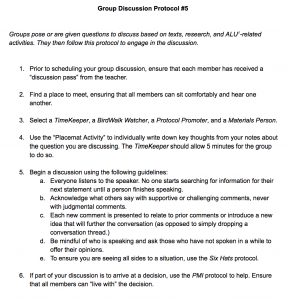In a Learner-Active, Technology-Infused Classroom, the teacher is a “bridge builder,” creating structures that allow students to take charge of their own learning. It’s important to ensure that at any point in time, you can look at a student and know what is going on in that student’s mind. Is real learning taking place?
Protocols can help! A protocol is a set of guidelines for interaction. A strong #LATIC bridge builder provides students with protocols. A direction sheet with clear steps to follow to complete an activity is a protocol for how students will engage with information toward learning. As students engage in group work and discussions, protocols can ensure that they are getting the most out of the experience.
You can teach students proper “rules of engagement” for discussions to make them productive. Once students build the skills, they will be able to schedule and engage in discussions on their own. Here is an example of a protocol for a group discussion (If you would like a pdf of this protocol and the others mentioned in here, please contact us using the box on the right.):

This protocol references a placemat activity to begin the discussion and a Six Hats and PMI chart for consensus building.
Th e National School Reform Faculty has a great collection of protocols to use with students. The key is to provide the “bridge” structures to allow students to take charge of their own learning.
e National School Reform Faculty has a great collection of protocols to use with students. The key is to provide the “bridge” structures to allow students to take charge of their own learning.
That frees up the teacher to facilitate and engage in important discussions around content rather than organizing student action. Empower your students; change the world!
